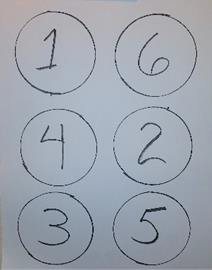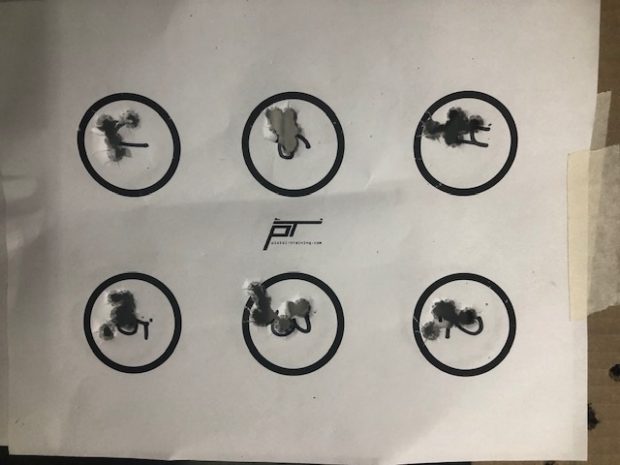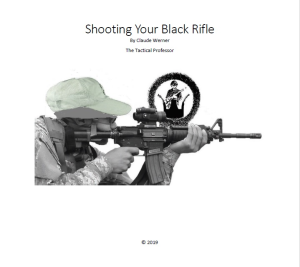Written by: Greg Ellifritz
My friend Claude Werner recently published a book titled “Shooting Your Black Rifle.” A large part of the book contains shooting drills and qualification courses for the AR-15 rifle.
One of the drills Claude developed is one that he calls the “Punto Banco.” It is a rifle adaptation of Tom Givens’ famous “Casino Drill“ utilizing a more generic target. On my last rifle training session, I shot the “Punto Banco.” I really liked it and thought about how I could adapt it to be shot with a pistol. This is what I came up with.
I used the printable target with six two inch circles from Pistol-Training.com. That link opens to a PDF. Download the target and then print out a few copies.
On your printed targets, use a sharpie marker to number each circle in the pattern pictured below (courtesy of Claude).

For your first try, place this target at three yards (nine feet).
Starting position- Chest ready or low ready
The drill, as explained by Claude:
“The object of Punto Banco is to shoot each circle with the number of shots indicated in each circle, no more and no less. Shooting the drill clean will result in thirty-nine hits in all the circles combined. The drill requires you to assess how well you shoot each circle in real time. Punto Banco teaches you to place reasonably accurate shots, rapidly shift your focus from target assessment to front sight, and to transition from target to target. It is an untimed drill.”
Sequence 1: (12 rounds)– Fire two shots on each circle in numerical order; (1), (2), (3), (4), (5), (6). If you miss any shot, before moving on to the next circle, you must make up the shots you missed. For example, if when shooting (2), you miss 1 shot, you must shoot 1 more shot, that hits, into it before continuing on to engage (3).
Sequence 2: (6 rounds)– Fire one shot on each circle in numerical order; (1), (2), (3), (4), (5), (6). If you miss any shot, before moving on to the next circle, you must make up the shots you missed. For example, if when shooting (2), you miss, you must shoot 1 more shot, that hits, into it before continuing on to engage (3).
Sequence 3: (21 rounds)– Fire (1) one time, (2) two times, (3) three times, (4) four times, (5) five times, and (6) six times. If you miss any shot, before moving on to the next circle, you must make up the shots you missed. For example, if when shooting (4), you miss 2 shots, you must shoot 2 more shots, that hit, into it before continuing on to engage (5). Reload as necessary during the Sequence.
Your target should have 39 hits in the six circles.
• 4 in (1)
• 5 in (2)
• 6 in (3)
• 7 in (4)
• 8 in (5)
• 9 in (6)”
Here is my first attempt at nine feet shooting the drill with my police duty gun (Glock 17).

I had only one problem with the drill. By the time I reached sequence three, all the target numbers had been destroyed by the bullet holes from the previous two sequences.
Claude’s original drill used much larger circles with a rifle at longer ranges. That issue never came up because half a dozen .223 holes in an eight -inch circle don’t obscure the target number. With a pistol shooting a larger diameter bullet at a much smaller target, the numbers start to disappear. When I do this one again, I will number my targets with the marker either above or below each dot instead of placing the number in the center of the area you are trying to destroy.
Did you get all your hits? Do you have more rounds to shoot? Do the drill again. If you made all of your hits, increase the range to 12 feet. If you had any misses, pull the target back in to six feet.
Still want more?
Put up a clean target at nine feet. Repeat Sequence Three (21 rounds) strong handed only. If you are feeling really sporty, do your reloads for this stage strong-handed only as well.
This is a challenging and fun 99-round pistol workout. Give it a try.
Then go buy Claude’s book if you are interested in adding some different rifle shooting drills and qualifications to your practice session.
Thanks to Tom Givens for his “Casino Drill.” Thanks also to Claude Werner for creating the rifle “Punto Banco” modification. You’ll have to read Claude’s book to learn the origin of his drill’s unique name. I stand on the shoulders of giants when I present my own take on the topic. Having a great bunch of “giants” to stand upon has allowed me to reach previously unfathomable heights.
And a special thanks to all of you folks who took time out of your busy day to read what I have written. I think you’ll enjoy the drill.

